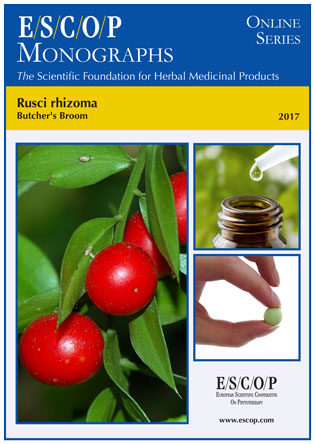 Rusci rhizoma
Rusci rhizoma
Butcher’s Broom
Ruscus aculeatus L.
Published 2017
Format: PDF
 Online viewing (for only €30 per year, you can view online all the monographs)
Online viewing (for only €30 per year, you can view online all the monographs)
SUMMARY:
The herbal monograph selects and summarises scientific studies and textbooks regarding efficacy, dosage and safety to support the therapeutic uses of butcher’s broom.
This herbal drug by definition consists of the dried, whole or fragmented underground parts of Ruscus aculeatus L.
Studies with its main characteristic constituents steroidal saponins are included.
The therapeutic indications are supportive therapy for symptoms of chronic venous insufficiency, such as painful, tired and heavy legs, tingling and swelling and supportive therapy for symptoms of haemorrhoids, such as itching and burning.
Administration of butcher’s broom addresses posology; its duration of use; contra-indications; special warnings; special precautions for use; interactions with other medicinal products; other forms of interaction; in pregnancy and lactation; its effects on ability to drive; undesirable effects; overdose.
In vitro and in vivo experiments with butcher’s broom demonstrate its vasoconstrictive and vasoprotective effects. Pharmacological studies in humans concern effects on venous function.
Controlled clinical studies with butcher’s broom demonstrated its therapeutic use in patients with chronic venous insufficiency and varicosis as well as in patients suffering from haemorrhoids.
Pharmacokinetics of orally administered Butcher’s broom extract and saponins were assessed in animals and humans.
Preclinical safety data were assessed in toxicity studies.
Safety data were assessed in human studies.
The selection of literature cited in the monograph is aimed at bringing together relevant information about the possible physiological roles of butcher’s broom and its major constituents.
KEYWORDS:
- Ruscus aculeatus L.
- Rusci rhizoma
- Butcher’s broom
- Chronic venous insufficiency; Haemorrhoids